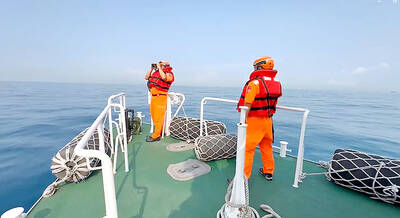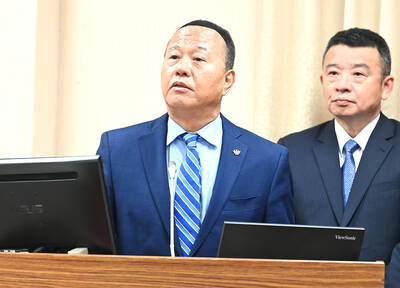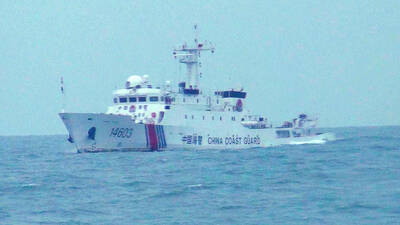Taiwan’s medical community is calling for a name change for schizophrenia (精神分裂症), which is derived from the Greek for “split mind,” in an effort to reduce the stigma attached to the disease and increase patients’ willingness to seek help.
They are proposing a name change to “cognitive-perception dysfunction (思覺失調症),” which suggests disorders of thoughts or consciousness and was inspired by the name “early psychosis,” which was adopted by Hong Kong in 2001.
“We propose the name change for the same reason that the government changed the Chinese name for dementia from ‘old-age feeble-mindedness’ (老人痴呆症) to ‘old-age intellectual losses’ (老人失智症) and replaced the term ‘mental retardation’ (低能) with ‘intellectual disability’ (智能不足),” Taiwanese Society of Psychiatry director-general Frank Chou (周煌智) told a press conference in Greater Tai
chung yesterday.
Chou said the term “cognitive-perception dysfunction” would not only make the symptoms of the disorder — such as delusions and hallucinations more comprehensible to people, but could also help remove common misconceptions and reduce discrimination.
“This would help alleviate patients’ fear of seeking medical assistance and letting others know about their condition,” Chou said.
Chou said a number of neighboring countries have taken the same step, with Japan and South Korea renaming the disorder: “integration disorder” and “attunement disorder” respectively.
The name change in Japan in 2002 has led to a noticeable increase in people’s willingness to receive treatments and the level of support they receive from their families, which prompted several Taiwanese mental-health experts, including National Taiwan University Hospital psychiatrist Hwu Hai-gwo (胡海國), to call for a similar change, Chou said.
“Although we have a numerical coding system to categorize diseases listed on disability certificates that are issued to people with mental disorders, we think that does not go far enough,” Chou said.
“We plan to submit reports to the Ministry of Education, the Ministry of Health and Welfare and the National Health Insurance Administration urging them to officially adopt our proposed name for the disease and consign the current one to history,” Chou added.
Taiwan Alliance for the Mentally Ill director-general Huang Min-wei (黃敏偉) said about 70 percent of people with mental disorders believe treatment could improve their condition, yet they often have to combat both the disease and the stigma attached to it.
According to a recent survey conducted by the alliance among 188 people who have recovered from mental illness, more than 60 percent said that they were reluctant to tell their family and friends about their condition due to fears of being discriminated against at work and in their personal lives.
Nevertheless, relevant statistics compiled by the administration in 2012 showed that the number of people diagnosed with mental disorders has climbed to nearly 120,000, from 75,000 over the past decade, which indicates a rising public awareness of mental diseases and an increased inclination among people to seek medical care, the alliance said.

An increase in Taiwanese boats using China-made automatic identification systems (AIS) could confuse coast guards patrolling waters off Taiwan’s southwest coast and become a loophole in the national security system, sources familiar with the matter said yesterday. Taiwan ADIZ, a Facebook page created by enthusiasts who monitor Chinese military activities in airspace and waters off Taiwan’s southwest coast, on Saturday identified what seemed to be a Chinese cargo container ship near Penghu County. The Coast Guard Administration went to the location after receiving the tip and found that it was a Taiwanese yacht, which had a Chinese AIS installed. Similar instances had also

GOOD DIPLOMACY: The KMT has maintained close contact with representative offices in Taiwan and had extended an invitation to Russia as well, the KMT said The Chinese Nationalist Party (KMT) would “appropriately handle” the fallout from an invitation it had extended to Russia’s representative to Taipei to attend its international banquet last month, KMT Chairman Eric Chu (朱立倫) said yesterday. US and EU representatives in Taiwan boycotted the event, and only later agreed to attend after the KMT rescinded its invitation to the Russian representative. The KMT has maintained long-term close contact with all representative offices and embassies in Taiwan, and had extended the invitation as a practice of good diplomacy, Chu said. “Some EU countries have expressed their opinions of Russia, and the KMT respects that,” he

VIGILANCE: The military is paying close attention to actions that might damage peace and stability in the region, the deputy minister of national defense said The People’s Republic of China (PRC) might consider initiating a hack on Taiwanese networks on May 20, the day of the inauguration ceremony of president-elect William Lai (賴清德), sources familiar with cross-strait issues said. While US Secretary of State Anthony Blinken’s statement of the US expectation “that all sides will conduct themselves with restraint and prudence in the period ahead” would prevent military actions by China, Beijing could still try to sabotage Taiwan’s inauguration ceremony, the source said. China might gain access to the video screens outside of the Presidential Office Building and display embarrassing messages from Beijing, such as congratulating Lai

Four China Coast Guard ships briefly sailed through prohibited waters near Kinmen County, Taipei said, urging Beijing to stop actions that endanger navigation safety. The Chinese ships entered waters south of Kinmen, 5km from the Chinese city of Xiamen, at about 3:30pm on Monday, the Coast Guard Administration said in a statement later the same day. The ships “sailed out of our prohibited and restricted waters” about an hour later, the agency said, urging Beijing to immediately stop “behavior that endangers navigation safety.” Ministry of National Defense spokesman Sun Li-fang (孫立方) yesterday told reporters that Taiwan would boost support to the Coast Guard